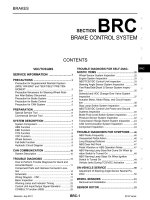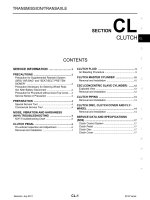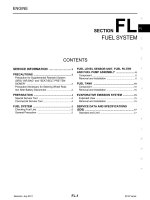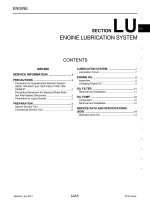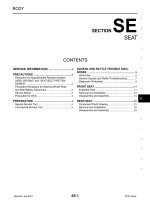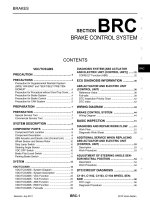HỆ THỐNG LY HỢP TRÊN NISSAN VERSA SEDAN ĐỜI 2012
Bạn đang xem bản rút gọn của tài liệu. Xem và tải ngay bản đầy đủ của tài liệu tại đây (683.87 KB, 21 trang )
CL-1
TRANSMISSION & DRIVELINE
C
E
F
G
H
I
J
K
L
M
SECTION CL
A
B
CL
N
O
P
CONTENTS
CLUTCH
PRECAUTION 2
PRECAUTIONS 2
Precaution for Supplemental Restraint System
(SRS) "AIR BAG" and "SEAT BELT PRE-TEN-
SIONER"
2
General Precautions 2
PREPARATION 3
PREPARATION 3
Special Service Tools 3
Commercial Service Tools 3
SYMPTOM DIAGNOSIS 4
NOISE, VIBRATION AND HARSHNESS
(NVH) TROUBLESHOOTING
4
NVH Troubleshooting Chart 4
PERIODIC MAINTENANCE 5
CLUTCH PEDAL 5
Inspection and Adjustment 5
CLUTCH FLUID 6
Inspection 6
Draining 6
Refilling 7
Air Bleeding 8
REMOVAL AND INSTALLATION 10
CLUTCH PEDAL 10
Exploded View 10
Removal and Installation 10
Inspection and Adjustment 10
CLUTCH MASTER CYLINDER 12
Exploded View 12
Removal and Installation 12
Inspection and Adjustment 13
CLUTCH PIPING 14
Exploded View 14
Hydraulic Layout 14
Removal and Installation 14
Inspection and Adjustment 15
UNIT REMOVAL AND INSTALLATION 16
CSC (CONCENTRIC SLAVE CYLINDER) 16
Exploded View 16
Removal and Installation 16
Inspection and Adjustment 17
CLUTCH DISC AND CLUTCH COVER 18
Exploded View 18
Removal and Installation 18
Inspection 19
SERVICE DATA AND SPECIFICATIONS
(SDS) 21
SERVICE DATA AND SPECIFICATIONS
(SDS)
21
General Specifications 21
Clutch Pedal 21
Clutch Disc 21
Clutch Cover 21
Revision: July 2011 2012 Versa Sedan
CL-2
< PRECAUTION >
PRECAUTIONS
PRECAUTION
PRECAUTIONS
Precaution for Supplemental Restraint System (SRS) "AIR BAG" and "SEAT BELT
PRE-TENSIONER"
INFOID:0000000007630768
The Supplemental Restraint System such as “AIR BAG” and “SEAT BELT PRE-TENSIONER”, used along
with a front seat belt, helps to reduce the risk or severity of injury to the driver and front passenger for certain
types of collision. This system includes seat belt switch inputs and dual stage front air bag modules. The SRS
system uses the seat belt switches to determine the front air bag deployment, and may only deploy one front
air bag, depending on the severity of a collision and whether the front occupants are belted or unbelted.
Information necessary to service the system safely is included in the SR and SB section of this Service Man-
ual.
WARNING:
• To avoid rendering the SRS inoperative, which could increase the risk of personal injury or death in
the event of a collision which would result in air bag inflation, all maintenance must be performed by
an authorized NISSAN/INFINITI dealer.
• Improper maintenance, including incorrect removal and installation of the SRS, can lead to personal
injury caused by unintentional activation of the system. For removal of Spiral Cable and Air Bag
Module, see the SR section.
• Do not use electrical test equipment on any circuit related to the SRS unless instructed to in this
Service Manual. SRS wiring harnesses can be identified by yellow and/or orange harnesses or har-
ness connectors.
PRECAUTIONS WHEN USING POWER TOOLS (AIR OR ELECTRIC) AND HAMMERS
WARNING:
• When working near the Airbag Diagnosis Sensor Unit or other Airbag System sensors with the Igni-
tion ON or engine running, DO NOT use air or electric power tools or strike near the sensor(s) with a
hammer. Heavy vibration could activate the sensor(s) and deploy the air bag(s), possibly causing
serious injury.
• When using air or electric power tools or hammers, always switch the Ignition OFF, disconnect the
battery, and wait at least 3 minutes before performing any service.
General Precautions INFOID:0000000007208102
WARNING:
After cleaning clutch disc, wipe it with a dust collector. Never use compressed air.
CAUTION:
• Always use recommended clutch fluid. Refer to MA-12, "
Fluids and Lubricants".
• Never reuse drained clutch fluid.
• Keep painted surface on the body and other parts free of clutch fluid. If fluid spills, wipe up immedi-
ately and wash the affected area with water.
• Never use mineral oils, such as gasoline or kerosene. It will ruin the rubber parts of the hydraulic
system.
• Never reuse CSC (Concentric Slave Cylinder). CSC slides back to the original position every time
when removing transaxle assembly. At this time, dust on the sliding parts may damage the seal of
CSC and may cause clutch fluid leakage. Refer to CL-16, "
Removal and Installation".
• Never disassemble clutch master cylinder and CSC.
Revision: July 2011 2012 Versa Sedan
PREPARATION
CL-3
< PREPARATION >
C
E
F
G
H
I
J
K
L
M
A
B
CL
N
O
P
PREPARATION
PREPARATION
Special Service Tools INFOID:0000000007208103
The actual shapes of Kent-Moore tools may differ from those of special service tools illustrated here.
Commercial Service Tools INFOID:0000000007208104
Tool number
(Kent-Moore No.)
Tool name
Description
ST20050240
(—)
Diaphragm adjusting wrench
Adjusting unevenness of diaphragm spring le-
ver
ZZA0508D
Tool name Description
Clutch aligner Installing clutch disc
Power tool Loosening bolts and nuts
MCIB0404E
PBIC0190E
Revision: July 2011 2012 Versa Sedan
CL-4
< SYMPTOM DIAGNOSIS >
NOISE, VIBRATION AND HARSHNESS (NVH) TROUBLESHOOTING
SYMPTOM DIAGNOSIS
NOISE, VIBRATION AND HARSHNESS (NVH) TROUBLESHOOTING
NVH Troubleshooting Chart INFOID:0000000007208105
Use the chart below to find the cause of the symptom. The numbers indicate the order of the inspection. If nec-
essary, repair or replace these parts.
Reference page
CL-5
CL-8
EM-82
CL-17
CL-19
EM-94
SUSPECTED PARTS (Possible cause)
CLUTCH PEDAL (Inspection and adjustment)
CLUTCH LINE (Air in line)
ENGINE MOUNTING (Loose)
CSC (Concentric Slave Cylinder) (Worn, dirty or damaged)
CLUTCH DISC (Out of true)
CLUTCH DISC (Runout is excessive)
CLUTCH DISC (Lining broken)
CLUTCH DISC (Dirty or burned)
CLUTCH DISC (Oily)
CLUTCH DISC (Worn out)
CLUTCH DISC (Hardened)
CLUTCH DISC (Lack of spline grease)
DIAPHRAGM SPRING (Damaged)
DIAPHRAGM SPRING (Out of tip alignment)
PRESSURE PLATE (Distortion)
FLYWHEEL (Distortion)
Symptom
Clutch grabs/chatters 1 2 2 2 2 2
Clutch pedal spongy 1 2
Clutch noisy 1
Clutch slips 1 2 2 3 4 5
Clutch does not disengage 12 333333 3445
Revision: July 2011 2012 Versa Sedan
CLUTCH PEDAL
CL-5
< PERIODIC MAINTENANCE >
C
E
F
G
H
I
J
K
L
M
A
B
CL
N
O
P
PERIODIC MAINTENANCE
CLUTCH PEDAL
Inspection and Adjustment INFOID:0000000007208106
1. Check to see if the master cylinder rod end moves freely. It
should not be bound by the clutch pedal.
a. If the rod end does not move freely, remove the rod end and
check for deformation or damage on the rod end. Leave the rod
end removed for step 2.
2. Check the clutch pedal stroke for free range of movement.
a. With the master cylinder rod end removed, manually move the
pedal up and down to determine if it moves freely.
b. If any sticking is noted, replace the clutch pedal assembly. Re-
verify that the master cylinder rod end moves freely.
3. Adjust clutch interlock switch (1) position so that clearance
between clutch pedal (2) and thread end of clutch interlock
switch (1), with clutch pedal fully depressed, is within specifica-
tion (C).
4. Check the clutch hydraulic system components (clutch master cylinder, clutch operating cylinder, clutch
withdrawal lever and clutch release bearing) for sticking or binding.
a. If any sticking or binding is noted, repair or replace the related parts as necessary.
b. If any hydraulic system repair was necessary, bleed the clutch hydraulic system. Refer to CL-8, "
Air
Bleeding".
PCIB1491E
Clearance C : 0.74 - 1.96 mm (0.0291 - 0.0772 in)
PCIB1493E
Revision: July 2011 2012 Versa Sedan
CL-6
< PERIODIC MAINTENANCE >
CLUTCH FLUID
CLUTCH FLUID
Inspection INFOID:0000000007208107
FLUID LEAKAGE
• Check clutch line for cracks, deterioration or other damage. Replace any damaged parts.
• Check for fluid leakage by fully depressing clutch pedal while engine is running.
CAUTION:
If leaks occur around connections, reinstall the lines or replace damaged parts, if necessary.
FLUID LEVEL
• Check that the fluid level in the reservoir tank is within the specified
range, between the MAX and MIN lines as shown.
• Visually check for any clutch fluid leaks around the reservoir tank.
• Check the clutch system for any leaks if the fluid level is extremely
low (lower than MIN).
Draining INFOID:0000000007208108
CAUTION:
Do not spill clutch fluid onto painted surfaces. If fluid spills, wipe up immediately and wash the
affected area with water.
1. Connect a transparent vinyl hose to air bleeder of bleeding con-
nector (1).
2. Press the lock pin (1) into the bleeding connector (2), and main-
tain the position.
JPFIA0007ZZ
JPDIB0144ZZ
PCIB1495E
Revision: July 2011 2012 Versa Sedan
CLUTCH FLUID
CL-7
< PERIODIC MAINTENANCE >
C
E
F
G
H
I
J
K
L
M
A
B
CL
N
O
P
3. Slide clutch tube (1) for the specified distance (A) in the direction
of the arrow ( ) as shown.
CAUTION:
Do not allow the clutch tube to disconnect from the bleed-
ing connector.
4. Depress clutch pedal to gradually discharge clutch fluid.
CAUTION:
Clutch tube is under hydraulic pressure; do not allow the clutch tube to disconnect from the
bleeding connector.
Refilling INFOID:0000000007208109
CAUTION:
Do not spill clutch fluid onto painted surfaces. If fluid spills, wipe up immediately and wash the
affected area with water.
1. Check that there is no foreign material in reservoir tank and then fill with new clutch fluid.
CAUTION:
Never reuse drained clutch fluid.
2. Connect a transparent vinyl hose to air bleeder of bleeding con-
nector (1).
3. Press the lock pin (1) into the bleeding connector (2), and main-
tain the position.
(2) : Bleeding connector
Dimension (A) : 5 mm (0.20 in)
JPDIB0147ZZ
JPDIB0144ZZ
PCIB1495E
Revision: July 2011 2012 Versa Sedan
CL-8
< PERIODIC MAINTENANCE >
CLUTCH FLUID
4. Slide clutch tube (1) for the specified distance (A) in the direction
of the arrow ( ) as shown.
5. Slowly depress clutch pedal to the full stroke position and then release the pedal.
CAUTION:
Clutch tube is under hydraulic pressure; do not allow the clutch tube to disconnect from the
bleeding connector.
6. Repeat step 5 at intervals of 2 or 3 seconds until new clutch fluid is discharged.
CAUTION:
Monitor clutch fluid level in reservoir tank so as not to empty the tank.
7. Return clutch tube and lock pin in their original positions while clutch pedal is depressed.
8. Perform the air bleeding. Refer to CL-8, "
Air Bleeding".
Air Bleeding INFOID:0000000007208110
CAUTION:
• Monitor clutch fluid level in reservoir tank so as not to empty the tank.
• Do not spill clutch fluid onto painted surfaces. If fluid spills, wipe up immediately and wash the
affected area with water.
1. Fill reservoir tank with new clutch fluid.
CAUTION:
Never reuse drained clutch fluid.
2. Connect a transparent vinyl hose to air bleeder of bleeding con-
nector (1).
3. Depress and release the clutch pedal slowly and fully 15 times
at an interval of 2 to 3 seconds and release the clutch pedal.
4. Press the lock pin (1) into the bleeding connector (2), and main-
tain the position.
CAUTION:
Clutch tube is under hydraulic pressure; do not allow the
clutch tube to disconnect from the bleeding connector.
(2) : Bleeding connector
Dimension (A) : 5 mm (0.20 in)
JPDIB0147ZZ
JPDIB0144ZZ
PCIB1495E
Revision: July 2011 2012 Versa Sedan
CLUTCH FLUID
CL-9
< PERIODIC MAINTENANCE >
C
E
F
G
H
I
J
K
L
M
A
B
CL
N
O
P
5. Slide clutch tube (1) for the specified distance (A) in the direction
of the arrow ( ) as shown and immediately depress the clutch
pedal and hold it, to bleed the air from the system.
CAUTION:
Clutch tube is under hydraulic pressure; do not allow the
clutch tube to disconnect from the bleeding connector.
6. Return clutch tube and lock pin in their original positions.
7. Release clutch pedal and wait for 5 seconds.
8. Repeat steps 3 to 7 until no bubbles are observed in the clutch fluid.
9. Check that the fluid level in the reservoir tank is within the specified range after air bleeding. Refer to CL-
6, "Inspection".
(2) : Bleeding connector
Dimension (A) : 5 mm (0.20 in)
JPDIB0147ZZ
Revision: July 2011 2012 Versa Sedan
CL-10
< REMOVAL AND INSTALLATION >
CLUTCH PEDAL
REMOVAL AND INSTALLATION
CLUTCH PEDAL
Exploded View INFOID:0000000007208111
Removal and Installation INFOID:0000000007208112
REMOVAL
1. Remove the instrument lower panel LH. Refer to IP-20, "Removal and Installation".
2. Disconnect master cylinder rod end from clutch pedal.
3. Disconnect clutch interlock switch connector.
4. Remove harness clip from clutch pedal.
5. Remove clutch pedal nuts and remove clutch pedal from the
vehicle.
6. Remove pedal pad from clutch pedal.
7. Remove clutch interlock switch and clip from clutch pedal.
8. Remove pedal stopper rubber from clutch pedal, using a suit-
able tool.
INSTALLATION
Installation is in the reverse order of removal.
CAUTION:
Press master cylinder rod end into clutch pedal until it stops.
Inspection and Adjustment INFOID:0000000007208113
INSPECTION AFTER REMOVAL
• Check clutch pedal for bend, damage, or a cracked weld. If bend, damage, or a cracked weld is found,
replace clutch pedal.
• Check pedal stopper rubber. If damage or deformation is found, replace pedal stopper rubber.
• Check pedal pad. If wear or damage is found, replace pedal pad.
INSPECTION AND ADJUSTMENT AFTER INSTALLATION
1. Clutch pedal 2. Pedal stopper rubber 3. Pedal pad
4. Clip 5. Clutch interlock switch
AWDIA0944GB
PCIB1491E
Revision: July 2011 2012 Versa Sedan
CLUTCH PEDAL
CL-11
< REMOVAL AND INSTALLATION >
C
E
F
G
H
I
J
K
L
M
A
B
CL
N
O
P
Inspect the clutch interlock switch position and adjust as necessary. Refer to CL-5, "Inspection and Adjust-
ment".
Revision: July 2011 2012 Versa Sedan
CL-12
< REMOVAL AND INSTALLATION >
CLUTCH MASTER CYLINDER
CLUTCH MASTER CYLINDER
Exploded View INFOID:0000000007208114
Removal and Installation INFOID:0000000007208115
CAUTION:
• Do not spill clutch fluid onto painted surfaces. If fluid spills, wipe up immediately and wash the
affected area with water.
• Never disassemble clutch master cylinder.
NOTE:
When removing components such as hoses, tubes/lines, etc., cap or plug openings to prevent fluid from spill-
ing.
REMOVAL
1. Remove battery. Refer to PG-61, "Removal and Installation".
2. Remove IPDM E/R bracket bolts (A) and nut (B).
3. Remove IPDM E/R bracket (1).
4. Remove ECM bracket nuts (A).
1. Reservoir hose 2. Master cylinder
JPDIB0222ZZ
: Vehicle front
JPDIC0818ZZ
: Vehicle front
JPDIB0233ZZ
Revision: July 2011 2012 Versa Sedan
CLUTCH MASTER CYLINDER
CL-13
< REMOVAL AND INSTALLATION >
C
E
F
G
H
I
J
K
L
M
A
B
CL
N
O
P
5. Remove master cylinder rod end ( ) from clutch pedal.
6. Use one of the following methods to remove hose from master
cylinder.
• Drain clutch fluid from reservoir tank and remove hose. Refer
to CL-6, "
Draining".
• Remove hose from master cylinder.
7. Pull up the lock pin (1) from connector of master cylinder (2) and
separate clutch tube (3).
8. Rotate master cylinder clockwise by 45 degrees and then
remove master cylinder from the vehicle.
INSTALLATION
CAUTION:
Do not spill clutch fluid onto painted surfaces. If fluid spills, wipe up immediately and wash the
affected area with water.
1. With the nipple (1) rotated clockwise by 45 degrees, insert clutch
master cylinder into the mounting hole. Rotate the clutch master
cylinder counterclockwise by 45 degrees (A) as shown to secure
it. At this time, nipple is in the upward (B).
2. Install master cylinder rod end to clutch pedal.
CAUTION:
Press master cylinder rod end into clutch pedal until it
stops.
3. Install reservoir hose to master cylinder.
4. Press down the lock pin into connector of master cylinder until it
stops.
5. Install clutch tube into connector of master cylinder until it stops.
6. Fill with clutch fluid and bleed clutch hydraulic system. Refer to CL-7, "
Refilling".
7. Installation of the remaining components is in the reverse order of removal.
Inspection and Adjustment INFOID:0000000007208116
INSPECTION AFTER INSTALLATION
Check for fluid leakage and check the fluid level. Refer to CL-6, "Inspection".
PCIB1491E
JPDIB0169ZZ
JPDIB0114ZZ
Revision: July 2011 2012 Versa Sedan
CL-14
< REMOVAL AND INSTALLATION >
CLUTCH PIPING
CLUTCH PIPING
Exploded View INFOID:0000000007208117
Hydraulic Layout INFOID:0000000007208118
Removal and Installation INFOID:0000000007208119
CAUTION:
Do not spill clutch fluid onto painted surfaces. If fluid spills, wipe up immediately and wash the
affected area with water.
NOTE:
When removing components such as hoses, tubes/lines, etc., cap or plug openings to prevent fluid from spill-
ing.
1. CSC (Concentric Slave Cylinder) 2. Clutch tube 3. Clutch damper
4. Bracket 5. Master cylinder
JPDIB0181ZZ
1. Clutch tube 2. Lock pin 3. CSC (concentric slave cylinder)
4. Clutch damper 5. Master cylinder 6. Clutch pedal
PCIB1499E
Revision: July 2011 2012 Versa Sedan
CLUTCH PIPING
CL-15
< REMOVAL AND INSTALLATION >
C
E
F
G
H
I
J
K
L
M
A
B
CL
N
O
P
REMOVAL
1. Remove the battery, battery tray and brackets. Refer to PG-61, "Removal and Installation".
2. Use one of the following methods to remove hose from clutch master cylinder.
• Drain clutch fluid from reservoir tank and remove hose. Refer to CL-6, "
Draining".
• Remove hose from clutch master cylinder.
3. Remove clutch tube lock pin from clutch master cylinder.
4. Remove clutch tube lock pin at clutch housing.
5. Remove clutch tube lock pins (2) from clutch damper (3).
6. Remove clutch tube (1) from clutch damper (3).
7. Remove clutch damper (3) from bracket (4).
INSTALLATION
Installation is in the reverse order of removal.
CAUTION:
Do not damage clutch tube.
• Insert each clutch tube into the CSC bleeding connector, the clutch damper connector, and the clutch master
cylinder connector until it contacts the end of each connector.
• Install each lock pin into the clutch damper connector and the clutch master cylinder connector until it con-
tacts the end of each connector.
• After installation, bleed the air from the clutch hydraulic system. Refer to CL-8, "
Air Bleeding".
Inspection and Adjustment INFOID:0000000007208120
INSPECTION AFTER REMOVAL
• Check the clutch tube for cracks and damage. If the clutch tube has cracks or damage, replace it with a new
one.
• Check the O-ring of the clutch tube for cracks and damage. If the O-ring of the clutch tube has cracks or
damage, replace clutch tube with a new one.
• Check the clutch damper for cracks and damage. If the clutch damper has cracks or damage, replace it with
a new one.
INSPECTION AFTER INSTALLATION
Check for fluid leakage and check the fluid level. Refer to CL-6, "Inspection".
WCIA0597E
Revision: July 2011 2012 Versa Sedan
CL-16
< UNIT REMOVAL AND INSTALLATION >
CSC (CONCENTRIC SLAVE CYLINDER)
UNIT REMOVAL AND INSTALLATION
CSC (CONCENTRIC SLAVE CYLINDER)
Exploded View INFOID:0000000007208121
Removal and Installation INFOID:0000000007208122
CAUTION:
• Never reuse CSC (concentric slave cylinder). CSC slides back to the original position every time
when removing transaxle assembly. At this time, dust on the sliding parts may damage the seal of
CSC and may cause clutch fluid leakage.
• Never disassemble CSC.
• Do not spill clutch fluid onto painted surfaces. If fluid spills, wipe up immediately and wash the
affected area with water.
REMOVAL
1. Remove transaxle assembly. Refer to TM-23, "Removal and Installation".
2. Remove CSC bolts and the CSC from clutch housing.
INSTALLATION
1. Install CSC to clutch housing and then tighten CSC bolts to the specified torque.
CAUTION:
• Do not reuse CSC.
• Do not insert and operate CSC when transaxle is removed. Piston and stopper of CSC compo-
nents may fall off.
2. Install transaxle assembly. Refer to TM-23, "
Removal and Installation".
1. Transaxle assembly 2. CSC (concentric slave cylinder)
JPDIB0146GB
PCIB1498E
Revision: July 2011 2012 Versa Sedan
CSC (CONCENTRIC SLAVE CYLINDER)
CL-17
< UNIT REMOVAL AND INSTALLATION >
C
E
F
G
H
I
J
K
L
M
A
B
CL
N
O
P
Inspection and Adjustment INFOID:0000000007208123
INSPECTION AFTER INSTALLATION
Check for fluid leakage and fluid level. Refer to CL-6, "Inspection".
ADJUSTMENT AFTER INSTALLATION
Perform the air bleeding. Refer to CL-8, "Air Bleeding".
Revision: July 2011 2012 Versa Sedan
CL-18
< UNIT REMOVAL AND INSTALLATION >
CLUTCH DISC AND CLUTCH COVER
CLUTCH DISC AND CLUTCH COVER
Exploded View INFOID:0000000007208124
Removal and Installation INFOID:0000000007208125
CAUTION:
• Never reuse CSC (concentric slave cylinder). CSC slides back to the original position every time
when removing transaxle assembly. At this time, dust on the sliding parts may damage the seal of
CSC and may cause clutch fluid leakage.
• Never allow any grease to contact the clutch disc facing, pressure plate surface and flywheel sur-
face.
• Never clean clutch disc using solvent.
REMOVAL
1. Remove transaxle assembly. Refer to TM-23, "Removal and Installation".
2. Loosen clutch cover bolts evenly. Then remove clutch cover and clutch disc.
INSTALLATION
1. Clean clutch disc and input shaft splines to remove grease and dust caused by abrasion.
2. Apply recommended grease to clutch disc and input shaft splines.
CAUTION:
Be sure to apply grease to the points specified. Otherwise, noise, poor disengagement, or damage
to the clutch may result. Excessive grease may cause slip or shudder. If grease adheres to seal of
CSC, it may cause clutch fluid leakage. Wipe off excess grease. Wipe off any grease oozing from
the parts.
1. Flywheel 2. Clutch disc 3. Clutch cover
4. Input shaft A. First step B. Final step
: Apply lithium-based grease including molybdenum disulphide.
AWDIA0948GB
Revision: July 2011 2012 Versa Sedan
CLUTCH DISC AND CLUTCH COVER
CL-19
< UNIT REMOVAL AND INSTALLATION >
C
E
F
G
H
I
J
K
L
M
A
B
CL
N
O
P
3. Install clutch disc, using suitable tool (A).
4. Install clutch cover and then temporarily tighten clutch cover
bolts.
5. Tighten clutch cover bolts to the specified torque evenly in two
steps in the numerical order as shown.
6. Install transaxle assembly. Refer to TM-23, "
Removal and Instal-
lation".
Inspection INFOID:0000000007208126
INSPECTION AFTER REMOVAL
Clutch Disc
• Measure clutch facing runout. If it is outside the specification,
replace clutch disc.
• Measure spline backlash at outer edge of clutch disc. If it is outside
the specification, replace clutch disc.
• Measure the depth (A) to clutch disc facing rivet heads, using suit-
able tool. If it exceeds the allowable wear limit, replace clutch disc.
Clutch Cover
• Check clutch cover thrust ring for wear or damage. If wear or damage is found, replace clutch cover.
NOTE:
• Worn thrust ring will generate a beating noise when tapped at the rivet using suitable tool.
• Broken thrust ring will make a clinking sound when cover is shaken up and down.
• If a trace of burn or discoloration is found on the clutch cover pressure plate to clutch disc contact surface,
repair the surface with sandpaper. If surface is damaged or distorted, replace clutch cover.
INSPECTION AFTER INSTALLATION
Clutch Cover
PCIB1503E
Runout limit/diameter of the area
to be measured
: Refer to CL-21,
"Clutch Disc".
Maximum allowable spline back-
lash (at outer edge of disc)
: Refer to CL-21,
"Clutch Disc".
SCL221
Facing wear limit (depth to the
rivet head) (A)
: Refer to CL-21,
"Clutch Disc".
JPDIB0026ZZ
Revision: July 2011 2012 Versa Sedan
CL-20
< UNIT REMOVAL AND INSTALLATION >
CLUTCH DISC AND CLUTCH COVER
Check diaphragm spring levers for unevenness with the clutch cover
installed on the engine. If they exceed the tolerance, adjust dia-
phragm spring lever height, using Tool (A).
Tolerance for diaphragm spring
lever unevenness
: Refer to CL-21,
"Clutch Cover".
Tool number : ST20050240 ( — )
JPDIB0160ZZ
Revision: July 2011 2012 Versa Sedan
SERVICE DATA AND SPECIFICATIONS (SDS)
CL-21
< SERVICE DATA AND SPECIFICATIONS (SDS)
C
E
F
G
H
I
J
K
L
M
A
B
CL
N
O
P
SERVICE DATA AND SPECIFICATIONS (SDS)
SERVICE DATA AND SPECIFICATIONS (SDS)
General Specifications INFOID:0000000007208127
Unit: mm (in)
Clutch Pedal INFOID:0000000007208128
Unit: mm (in)
Clutch Disc INFOID:0000000007208129
Unit: mm (in)
Clutch Cover INFOID:0000000007208130
Unit: mm (in)
Engine type HR16DE
Type of clutch control Hydraulic
Clutch disc Facing size (Outer dia. × Inner dia. × Thickness) 200 × 140 × 3.1 (7.87 × 5.51 × 0.122)
Recommended clutch fluid Refer to MA-12, "
Fluids and Lubricants".
Engine type HR16DE
Clutch pedal height 158.8 – 168.8 (6.25 – 6.65)
Clutch pedal height at clutch disengagement 73 (2.87) or more
Clutch pedal play
[Looseness at clutch pedal pin]
2 – 8 (0.08 – 0.31)
[0 – 1.3 (0 – 0.051)]
Clearance between clutch pedal and clutch interlock switch
threaded end while clutch pedal is fully depressed.
0.2 – 1.96 (0.008 – 0.0772)
Engine type HR16DE
Clutch facing runout limit / diameter of the area to be measured 1.0 (0.039) / 190 (7.48) dia.
Maximum allowable spline backlash (at outer edge of disc) 0.8 (0.031)
Clutch facing wear limit (depth to the rivet head) 0.3 (0.012)
Engine type HR16DE
Tolerance for diaphragm spring lever unevenness 0.7 (0.028) or less
Revision: July 2011 2012 Versa Sedan
